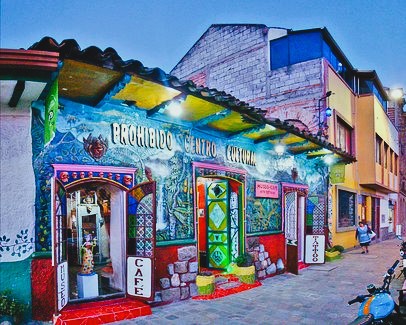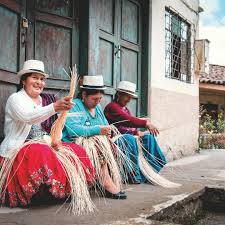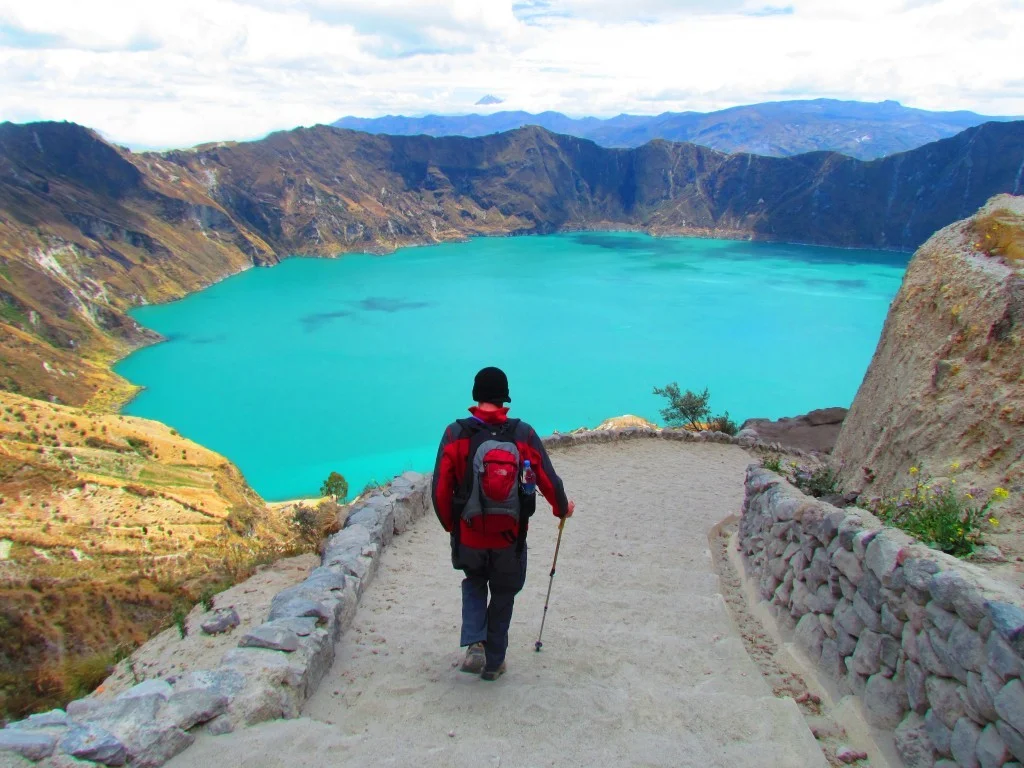Welcome to the heart of Cuenca, where art and culture converge in the most unexpected ways. Nestled in the historic El Vado neighborhood, the Prohibido Centro Cultural is not just a venue; it’s a movement that challenges the norms and celebrates the avant-garde. Founded by the visionary artist Eduardo Moscoso in 1996, this cultural center has become a sanctuary for alternative artistic expressions, from provocative sculptures to thought-provoking performances.
Imagine stepping into a space where every corner tells a story, where the boundaries of conventional art are continuously pushed. The Prohibido Centro Cultural is a testament to the power of art in fostering open-mindedness and breaking societal taboos. Its exhibitions delve into themes often considered controversial, such as sexuality, death, and religion, making it a must-visit for those seeking to experience the raw and unfiltered emotions of contemporary art.
As you wander through this unique cultural hub, you’ll not only witness the masterpieces of Moscoso himself but also discover works by emerging artists who share his vision. The center’s mission is to create a platform for voices that are often marginalized, providing a space where freedom of expression is not just allowed but celebrated.
If you’re planning a trip to Cuenca, the Prohibido Centro Cultural should undoubtedly be on your itinerary. Whether you’re an art aficionado or simply curious about alternative cultural expressions, this center offers a transformative experience that will leave you pondering long after your visit. Ready to dive deeper into the world of Cuenca’s most daring art scene? Let’s explore what makes the Prohibido Centro Cultural a cornerstone of artistic innovation.
The Fascinating History of Prohibido Centro Cultural
Established in 1996 by the visionary artist Eduardo Moscoso, the Prohibido Centro Cultural in Cuenca, Ecuador, has become a beacon for alternative art forms. Despite facing initial resistance due to its controversial themes, it has evolved into a respected cultural institution. The center’s story is as compelling as the art it showcases, reflecting a journey of perseverance, acceptance, and transformation.
The building that houses the Prohibido Centro Cultural is steeped in history. Originally constructed over 200 years ago, it has served various purposes, including a hotel and a family residence. The structure, made from adobe and bahareque with a traditional tile roof, has been meticulously preserved and restored by its current owners, adding to its architectural significance.
The Founding Vision
Eduardo Moscoso founded the Prohibido Centro Cultural out of a need to express his art freely. At the time, Cuenca’s society was notably conservative, and Moscoso’s works, which often explored themes of sexuality, death, and religion, were not well-received in traditional galleries. This led him to create a space where such ‘prohibited’ art could be displayed without censorship.
Moscoso’s vision was to challenge societal norms and provoke thought through art. His determination to provide a platform for alternative expressions has not only allowed his own work to flourish but has also paved the way for other artists who share his vision.
Early Challenges and Resistance
The early days of the Prohibido Centro Cultural were fraught with challenges. The controversial nature of the exhibits often led to backlash from the local community. Artworks were sometimes vandalized or stolen, and the center faced significant opposition from those who were uncomfortable with its themes.
Despite these hurdles, Moscoso remained steadfast in his mission. He believed in the power of art to foster open-mindedness and continued to push the boundaries of conventional art. Over time, the center began to gain acceptance, and its exhibitions started to attract a more diverse audience.
Evolution and Acceptance
As the Prohibido Centro Cultural gained recognition, it evolved into a vibrant hub for alternative art. The center now hosts a variety of artistic expressions, including music, theater, painting, sculpture, and video art. It has become a sanctuary for artists who wish to explore themes that are often considered taboo.
Today, the center is not only a place for Moscoso’s works but also a platform for emerging artists. It collaborates with both national and international artists, offering a space where diverse voices can be heard. The Prohibido Centro Cultural stands as a testament to the transformative power of art and its ability to challenge and change societal perceptions.
For those visiting Cuenca, the Prohibido Centro Cultural offers a unique glimpse into the city’s avant-garde art scene. It is a must-visit for anyone interested in experiencing the raw and unfiltered emotions that contemporary art can evoke.
Exploring the Unique Exhibits at Prohibido Centro Cultural
The Prohibido Centro Cultural in Cuenca, Ecuador, is renowned for its provocative and thought-provoking exhibits. This cultural hub challenges societal norms and encourages reflection through its diverse array of artworks. The exhibits delve into themes such as sexuality, death, and fetishes, making it a unique destination for those seeking to explore the avant-garde.
Visitors to the Prohibido Centro Cultural can expect to encounter a variety of exhibits that push the boundaries of conventional art. The center’s collection is designed to provoke thought and challenge preconceived notions, offering a transformative experience for all who enter its doors.
Sexuality: Breaking Taboos
One of the central themes at the Prohibido Centro Cultural is sexuality. The exhibits in this category aim to break societal taboos and encourage open discussions about sexual expression. Through a combination of sculptures, paintings, and multimedia installations, the center explores the complexities of human sexuality in a candid and unapologetic manner.
Notable pieces include Eduardo Moscoso’s provocative sculptures that challenge traditional views on gender and sexuality. These works invite viewers to reflect on their own beliefs and consider alternative perspectives. As one visitor noted, “The exhibits on sexuality at Prohibido Centro Cultural are both shocking and enlightening, offering a fresh take on a topic often shrouded in secrecy.”
Death: Confronting Mortality
Another prominent theme at the Prohibido Centro Cultural is death. The center’s exhibits on this topic encourage visitors to confront their own mortality and consider the cultural and personal significance of death. Through a variety of artistic mediums, the center presents death not as an end, but as a part of the human experience that deserves contemplation and understanding.
Highlights include the “Muerte Santa y Virgen” sculpture, which draws from Mexican traditions to depict the duality of life and death. This piece, along with others in the collection, invites viewers to engage with the concept of death in a meaningful way. As a reviewer mentioned, “The art at Prohibido Centro Cultural transforms the fear of death into a profound appreciation for life.”
Fetishes: Exploring the Unconventional
The theme of fetishes is also explored at the Prohibido Centro Cultural. These exhibits delve into the unconventional and often misunderstood aspects of human desire. By presenting fetishes through art, the center aims to demystify and destigmatize these expressions of human sexuality.
One of the standout pieces in this category is the “Divino Diablito” sculpture, which uses a mix of materials to create a visually striking representation of fetishistic themes. This piece, along with others, encourages viewers to question societal norms and embrace the diversity of human desires. A visitor’s review captures the essence of these exhibits: “Prohibido Centro Cultural’s fetish-themed art is daring and thought-provoking, challenging visitors to rethink what they consider ‘normal.'”
In summary, the Prohibido Centro Cultural offers a unique and immersive experience through its exhibits on sexuality, death, and fetishes. Each piece is carefully curated to provoke thought and inspire reflection, making it a must-visit destination for those interested in exploring the boundaries of contemporary art.
Visitor Information and Tips for Prohibido Centro Cultural
Visiting the Prohibido Centro Cultural in Cuenca, Ecuador, offers a unique and enriching experience. This section provides practical information, including location, opening hours, and tips for making the most of your visit.
Whether you’re an art enthusiast or a curious traveler, knowing the essential details will help you plan your visit effectively. Here’s everything you need to know before heading to this avant-garde cultural hub.
Location and How to Get There
The Prohibido Centro Cultural is located in the historic El Vado neighborhood, a charming area known for its colonial architecture and vibrant cultural scene. The exact address is:
- Address: Calle La Cruz y Calle peatonal La Condamine 12-102, Cuenca, Ecuador
Getting there is straightforward:
- By Taxi: Taxis are readily available throughout Cuenca. Simply provide the address to the driver.
- By Bus: Several bus lines pass through the El Vado neighborhood. Check local bus routes for the most convenient option.
- On Foot: If you’re staying in the historic center, the cultural center is within walking distance. Enjoy a pleasant stroll through Cuenca’s picturesque streets.
Opening Hours and Admission Fees
To make the most of your visit, it’s important to know the opening hours and admission fees:
- Opening Hours: The center is open from Tuesday to Sunday, 10:00 AM to 6:00 PM. It closes on Mondays.
- Admission Fees: The entry fee is $2.50 per person. Special discounts may be available for students and seniors.
What to Expect During Your Visit
The Prohibido Centro Cultural is famous for its provocative and thought-provoking exhibits. Here’s what you can expect:
- Diverse Art Forms: The center showcases a variety of artistic expressions, including sculptures, paintings, multimedia installations, and performances.
- Controversial Themes: The exhibits often explore themes such as sexuality, death, and fetishes, challenging societal norms and encouraging open-mindedness.
- Interactive Experiences: Some exhibits are interactive, allowing visitors to engage directly with the art.
Tips for Enhancing Your Visit
To ensure a memorable experience at the Prohibido Centro Cultural, consider the following tips:
- Take Your Time: The exhibits provoke thought and reflection. Allocate enough time to fully immerse yourself in the experience.
- Engage with the Art: Don’t hesitate to ask questions or participate in interactive exhibits. The staff is knowledgeable and can provide valuable insights.
- Respect the Space: Some exhibits may be sensitive in nature. Approach each piece with an open mind and respect for the artist’s vision.
- Combine with Other Attractions: The El Vado neighborhood is rich in history and culture. Consider exploring nearby attractions to make the most of your visit to Cuenca.
For more information about planning your trip to Cuenca and discovering other cultural gems, visit our website.
Experience the Unconventional Art at Prohibido Centro Cultural
The Prohibido Centro Cultural in Cuenca, Ecuador, offers an unparalleled journey into the world of avant-garde art. As you navigate through its provocative exhibits, you’ll find yourself immersed in a space that challenges societal norms and invites deep reflection on themes such as sexuality, death, and fetishes. This cultural hub is not just a gallery but a movement that celebrates the freedom of expression and the power of art to provoke thought and inspire change.
From its inception in 1996 by Eduardo Moscoso, the Prohibido Centro Cultural has grown from a controversial initiative into a respected institution. The center’s history is a testament to perseverance and the transformative power of art. Its exhibits, ranging from Moscoso’s own provocative sculptures to works by emerging artists, offer a raw and unfiltered view of contemporary issues. Each piece evoke strong emotions and encourage visitors to reconsider their preconceived notions.
For those planning a visit, the Prohibido Centro Cultural provides a comprehensive experience that goes beyond traditional art appreciation. Located in the historic El Vado neighborhood, the center is easily accessible by taxi, bus, or on foot. With its affordable admission fee and convenient opening hours, it makes for an enriching addition to any Cuenca itinerary. Take your time to engage with the art, participate in interactive exhibits, and explore the surrounding neighborhood to fully appreciate the cultural richness of this unique destination.
Key Takeaways
- Explore thought-provoking themes of sexuality, death, and fetishes.
- Witness the transformative power of art that challenges societal norms.
- Engage with interactive exhibits for a deeper understanding.
- Plan your visit with practical information on location, hours, and fees.
Ready to dive into Cuenca’s most daring art scene? Visit the Prohibido Centro Cultural and experience the unconventional. For more insights into Cuenca’s cultural gems, check out our other articles on our website. Don’t miss the chance to explore the rich artistic landscape that this vibrant city has to offer.




